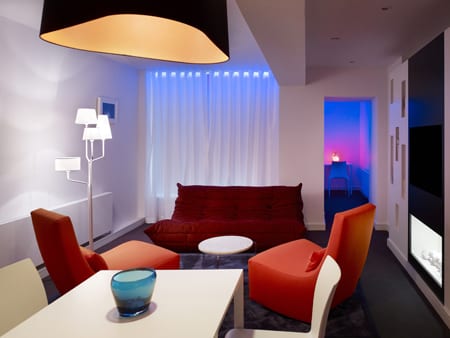Hospitality Design (HD) magazine and Culintro, a culinary trade organization in New York that brings together restaurant professionals, have teamed up to bring a monthly online Q&A with some of the nation’s top restaurant designers. Each month, we will feature a Q&A with an industry leader, talking about his/her newest project, the industry, what works, and what’s next.
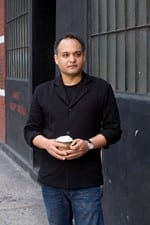 Anurag Nema
Anurag Nema
nemaworkshop
New York, NY
Collaboration is the backbone of nemaworkshop’s bold designs. Led by Anurag Nema, who caught his big break working for David Rockwell, the New York firm has a knack for creating spaces reflective of their social context, whether upbeat hangout Delicatessen or modern-bookish d’Espresso (a recent HD Award winner). Here, Nema talks public space, the joys of engaged clients, and inspired strolls.
HD: Did you always know you wanted to be a designer?
AN: When my parents were designing our home in India, they worked with an architect who was a close friend of theirs. I remember going to his office and being absolutely fascinated by the whole environment-the books, the drawings, the models. I knew then that this was something I wanted to be part of.
HD: What are some of your first memories of design?
AN: My first connection to design was through art. I remember spending a lot of time in the National Gallery of Modern Art in New Delhi with my family. We also saw a lot of theater in Bhopal and I was fascinated by the sets. My interest in art and sculpture eventually led me to pursue architecture.
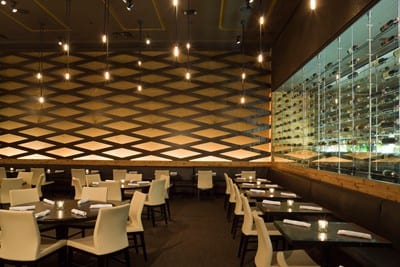
HD: How did you end up where you are today-school, first jobs?
AN: Architecture school in Bhopal, master’s [in South Carolina] at Clemson University; great place-it’s creative, intellectual, experimental. After that I worked for a large corporation doing institutional projects where I learned less about design than about the construction process. But really, the pivotal point was working for David Rockwell-being in New York and in a creative, fun studio environment was incredible. The tremendous energy and enthusiasm for design and art was pulsing through the firm. It was a great environment to experiment and develop as a designer. I’m really grateful for having worked there and with such talented, inspired people.
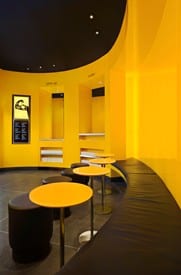
HD: Why hospitality?
AN: A city is a fantastically complex organism, which depends on social interaction. Restaurants, bars, lounges, hotels, and cafes give people public space in which to access one another: to laugh, share, savor, dance, and connect. More so than museums and parks, restaurants are the public spaces where we connect to one another. It is the fibers of hospitality running through the chaos of urban life that give a city its vitality.
HD: Why did you decide to start your own firm?
AN: A friend of a friend asked me to design his apartment and then it all just spiraled. One project led to another and then another…

HD: Name one project you are most proud of and why?
AN: Really, each project has a moment I’m most excited about. At Delicatessen it’s the connection to the street; at Subtletea it’s about the relationship between new and old; at d’Espresso it’s the definition of a brand with a single bold architectural move. They all have their strengths.
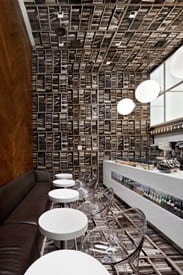
HD: What’s next?
AN: A new hotel brand, a restaurant for a celebrity chef and mixologist, some residential projects, and we are getting more into retail, too.
HD: Do you have a greatest lesson learned?
AN: To listen. We’ve been fortunate to have some really smart clients. Not only do they have strong ideas and opinions, but they are also grounded in practical experience and first-hand knowledge. Designers like to talk about expression and showcase big ideas, however, the first step in the process is listening to the client, understanding the context, and absorbing the ideas.
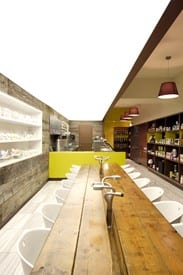
HD: What was your first reality check?
AN: I guess I’ve always stayed pretty grounded.
HD: How would you describe your office culture?
AN: We have a team of young people who embrace collaboration. We really push each other, challenge ideas because ultimately we are all seeking something fresh, clever, and strong that we can get really excited about. It makes for a super fun process where we experiment and explore using physical models, computer renderings, drawings, lighting, and whatever else we discover along the way. That richness embedded in the exploratory process pulses through the design. It’s pretty incredible when you have a dynamic, talented, creative team because the results are something more than what any individual could imagine.
HD: What would be your dream project?
AN: Airports, installations, and event spaces. Addressing the traveler is so seductive because the traveler is inherently vulnerable and curious. The question is: How can the design make someone feel comfortable and welcome in a foreign environment while exploring and discovering?
HD: When you are not in the office we can find you…
AN: Walking around the city. There is just so much to see. I love being part of this city and I make new discoveries all the time.
HD: Design is…
AN: Inevitable.
HD: Mentor?
AN: I’d love to have one.
HD: Where do you find inspiration?
AN: I find inspiration in a wide range of disciplines including music, film, cuisine, fashion, theater, pop culture, and in stories and accidents. That’s what’s so fantastic about inspiration-it’s everywhere.

